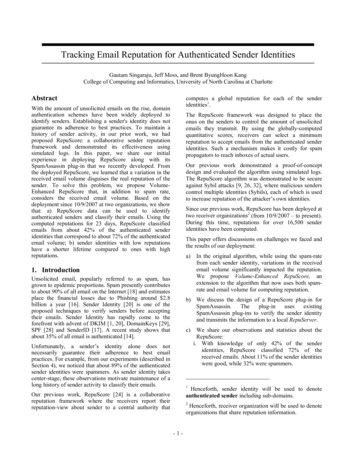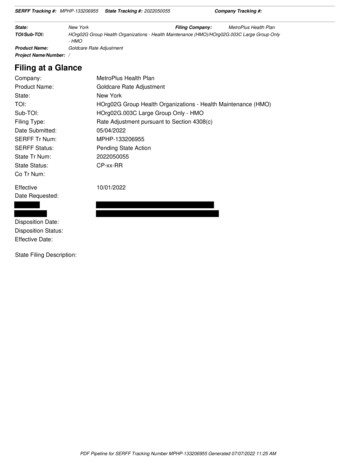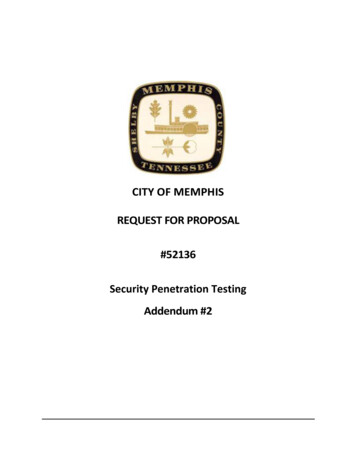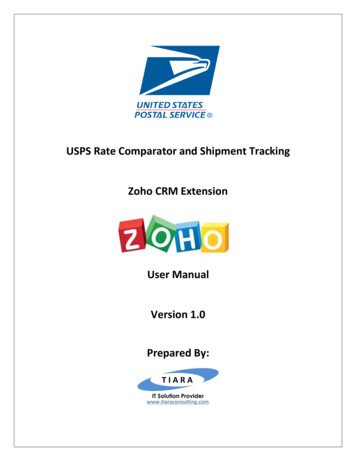
Transcription
Tracking Email Reputation for Authenticated Sender IdentitiesGautam Singaraju, Jeff Moss, and Brent ByungHoon KangCollege of Computing and Informatics, University of North Carolina at CharlotteAbstractcomputes a global reputation for each of the senderidentities1.With the amount of unsolicited emails on the rise, domainauthentication schemes have been widely deployed toidentify senders. Establishing a sender's identity does notguarantee its adherence to best practices. To maintain ahistory of sender activity, in our prior work, we hadproposed RepuScore: a collaborative sender reputationframework and demonstrated its effectiveness usingsimulated logs. In this paper, we share our initialexperience in deploying RepuScore along with itsSpamAssassin plug-in that we recently developed. Fromthe deployed RepuScore, we learned that a variation in thereceived email volume disguises the real reputation of thesender. To solve this problem, we propose VolumeEnhanced RepuScore that, in addition to spam rate,considers the received email volume. Based on thedeployment since 10/9/2007 at two organizations, we showthat: a) RepuScore data can be used to identifyauthenticated senders and classify their emails. Using thecomputed reputations for 23 days, RepuScore classifiedemails from about 42% of the authenticated senderidentities that correspond to about 72% of the authenticatedemail volume; b) sender identities with low reputationshave a shorter lifetime compared to ones with highreputations.The RepuScore framework was designed to place theonus on the senders to control the amount of unsolicitedemails they transmit. By using the globally-computedquantitative scores, receivers can select a minimumreputation to accept emails from the authenticated senderidentities. Such a mechanism makes it costly for spampropagators to reach inboxes of actual users.Our previous work demonstrated a proof-of-conceptdesign and evaluated the algorithm using simulated logs.The RepuScore algorithm was demonstrated to be secureagainst Sybil attacks [9, 26, 32], where malicious senderscontrol multiple identities (Sybils), each of which is usedto increase reputation of the attacker’s own identities.Since our previous work, RepuScore has been deployed attwo receiver organizations2 (from 10/9/2007 – to present).During this time, reputations for over 16,500 senderidentities have been computed.This paper offers discussions on challenges we faced andthe results of our deployment:a)1. IntroductionUnsolicited email, popularly referred to as spam, hasgrown to epidemic proportions. Spam presently contributesto about 90% of all email on the Internet [18] and estimatesplace the financial losses due to Phishing around 2.8billion a year [16]. Sender Identity [20] is one of theproposed techniques to verify senders before acceptingtheir emails. Sender Identity has rapidly come to theforefront with advent of DKIM [1, 20], DomainKeys [29],SPF [28] and SenderID [17]. A recent study shows thatabout 35% of all email is authenticated [14].In the original algorithm, while using the spam-ratefrom each sender identity, variations in the receivedemail volume significantly impacted the reputation.We propose Volume-Enhanced RepuScore, anextension to the algorithm that now uses both spamrate and email volume for computing reputation.b) We discuss the design of a RepuScore plug-in forSpamAssassin.Theplug-inusesexistingSpamAssassin plug-ins to verify the sender identityand transmits the information to a local RepuServer.c)Unfortunately, a sender’s identity alone does notnecessarily guarantee their adherence to best emailpractices. For example, from our experiments (described inSection 4), we noticed that about 89% of the authenticatedsender identities were spammers. As sender identity takescenter-stage, these observations motivate maintenance of along history of sender activity to classify their emails.We share our observations and statistics about theRepuScore:i. With knowledge of only 42% of the senderidentities, RepuScore classified 72% of thereceived emails. About 11% of the sender identitieswere good, while 32% were spammers.1Henceforth, sender identity will be used to denoteauthenticated sender including sub-domains.Our previous work, RepuScore [24] is a collaborativereputation framework where the receivers report theirreputation-view about sender to a central authority that2Henceforth, receiver organization will be used to denoteorganizations that share reputation information.-1-
the sender domain’s IP addresses. Basing reputation onthe domain name strongly ties an organization with itspast email activity because (i) an IP address does notintuitively translate to a domain name [8]; (ii) multipleorganizations can share an IP address; (iii) credibleorganizations in general would maintain their domainname for a longer period of time than their IP addresses.ii. 97.8% of the sender identities had reputation eithernear 0 or near 1.iii. Sender identities with low reputation have a shorterlifetime as compared to ones with high reputation.Average lifetime of good and bad sender identitywas 61.9 and 17.47 days respectively.iv. A large number of sender identities are createdconstantly that sent emails only in a single interval.v. Reputation can be accurate in determining if asender identity is a spammer.This paper has been organized as follows: Section 2discusses the related work, and Section 3 describes ourdeployment at a single receiver organization. Section 4presents our results and we finally conclude in Section 5.Project Lumos [13] was proposed as an effort to providereputation among collaborating ISPs. However, theproject does not seem to be actively deployed yet. ProjectLumos was intended to provide a receiver feedback todetermine if the sender is a spammer or otherwise. Itsuggested reputation based on the weighted average of thepast and present reputation views. Project Lumosconsidered all reputation reporters to be genuine, andtherefore, did not consider attacks, such as Sybil Attacks,from reputation submitters.2. Related Work and BackgroundIn this section, we discuss sender identity frameworks,followed by existing reputation management frameworksfor email and peer-to-peer networks.Cloudmark’s Network Classifier [21] is a communitybased filter-system where multiple agents submitfeedback about emails to nomination servers whichrequire multiple users to confirm the claim that an emailis spam. This information is submitted to a central serverknown as the Trust Evaluation System which computes aglobal view for an email’s fingerprint. The Cloudmarkpaper advises not to use authenticated domain name as afingerprint, as this would lead to a high multiplicity andcross-collision rate. In RepuScore, instead of using afingerprint, we use the authenticated domain name tomaintain reputation for each sender.Sender Identification techniquesTo identify a valid sender, sender identification techniquessuch as SenderID [17], Sender Policy Framework (SPF)[28], Domain Key Identified Mail (DKIM) [1, 20] andDomainKeys [29] have been developed. SPF verifies if thesender’s email server is authorized to send email for thesender’s domain. SenderID differs from SPF in its abilityto authenticate either the “envelope from” header or the“purported responsible address”. Using DKIM andDomainKeys, senders publish a set of public keys as a partof DNS; emails are then signed by their mail server.Receivers verify the signature, and hence, the sender.Accredited DomainKeys [10] suggests the use of a centralserver that monitors the senders’ activity to evaluate them.Reputation can be one way to monitor the sender activity.Google’s reputation system [4] identifies senders usingbest-guess SPF or DKIM and computes the sender’sreputation based on user inputs. Google’s reputationsystem demonstrates high accuracy in classifying theiremails. The author points out the need for a third partycross-domain collaborative reputation framework.A recent study reports that 35% of all email isauthenticated using one of the sender identity techniques[14]. Reputation frameworks based on a sender identitytechnique can reliably classify senders to maintain areliable history of conformance to a common guideline.Reputation Management for Email InfrastructureSenderPath’s SenderScore Certified [23], Habeas’ Safelist[12] and Goodmail’s Certified Email [5] are certificationand accreditation services that allow bulk senders toobtain third party certification. These systems do notqualify as reputation systems, as the senders control theirown reputation rather than the receivers assigningreputations for them.Email reputation can use either the senders’ IP addresses ortheir domain name as a basis to assign reputation.Reputation Management in Peer-to-Peer systemsReputation management techniques have been used inagent based systems [25, 27] as a mechanism to evaluatetrust. In multi-agent systems, peers use reputation toevaluate other agents to be able to select the best courseof action to maximize their outcome [19]. Reputationsystems have been prone to Sybil attacks [9] where asingle attacker uses multiple identities to submit multiplereputation votes about its peers. Such attacks aredetrimental to honest users and amicable to the attacker.SenderPath’s Sender Score [22] and Habeas’ SenderIndex[11] provide reputation for a sender’s IP address.SecureComputing’s TrustedSource [7] provides a globalreputation system with the help of their deployed mailservers across multiple organizations. These organizationsfocus on creating a set of bad sender IP addresses (notdomain names) to reject emails from them.To create a group of senders whose prolonged historyvouches for its email best practices, a reputationmanagement system should use a domain name rather than-2-
For all Sender Identities:Single vote perorganizationPresentRep (Number of Good Emails)/ (Number of Emails)CentralAuthorityIf ( ReportedRep (at Interval m-1) PresentRep)RepuCollectorReportedRep (at Interval m) α ReportedRep (at Interval m-1) (1-α) eRepuServerReportedRepu (at Interval m) ReceiverOrganization 1(1–α) ReportedRep (at Interval m-1) α PresentRepα varies between (0, 1); α is the correlation factor thatdetermines the importance placed in the past or present. rReceiverOrganization 2LocalRepuServerAlgorithmFigure 1: RepuScore Framework across receiverorganizations. Each organization is allowed a singlevote. Reputations is computed every ReputationInterval.α is closer to 0, the present interval is emphasized.α is closer to 1, the past interval is emphasized.Equation 1: RepuServer reputation maintainshistory of spam rate as to maintain reputation.reputation for sender identities. Using such a collaborativescheme, organizations with relatively few users canclassify emails from authenticated sender identities.Global Reputation (at Interval m) Sum of {RepuCollector’s Repu (at interval m-1) ce spammers frequently take new identities, a set ofhigh-spam propagating sender identities cannot exist. Incomparison, the group of non-spam propagating senderidentities does not change frequently. Sender identitiesabout which RepuScore does not have any informationcan be classified using other email classificationtechniques.Sum of All {RepuCollector Repu (at Interval m-1)}Equation 2: Central Authority computes globalreputation. To thwart Sybil Attacks, differentweight is applied based on the RepuCollector’sreputation.RepuScore introduces a central authority that collectsreputation from multiple receiver organizations.RepuScore’s centralized design enables receiverorganizations to enforce reputations and removemalicious senders from a trusted group.To protect against deception and attacks in cooperativereputation systems, inputs from honest users are consideredmore valuable. The effectiveness of reputation protocolscan be measured by their success in thwarting Sybilattacks. Using user personalized reputations in addition tothe global reputations of the senders is one mechanismsuggested to harden the reputation frameworks [6].Figure 1 demonstrates the RepuScore architecture withthe different entities, namely the RepuServer, theRepuCollector and the Central Authority, where:a)Using eigenvectors, EigenTrust [15] uses global reputationto identify malicious peers. Future reputation is calculatedbased on the present normalized trust reputation of all thepeers. Due to the feedback mechanism, EigenTrust is aself-policing system that regards a trusted peer more thanthat of a peer of low-repute. Such a mechanism is helpfulin guarding against Sybil attacks.RepuServers periodically compute reputations forsender identities as seen at the mail server;b) RepuCollectors compute reputations for senderidentities as seen from all mail servers at theorganization;c)Another reputation framework has been developed as anapplication-independent system [30]. This systemconsiders the multi-player prisoners dilemma, where everyagent tries to maximize its own profits while maintainingthe trust of other nodes. The system also incorporates [31]a mechanism to detect deceptions and reduce the effect ofmalicious votes from such peers.Central Authority computes global reputation bycombining scores submitted by all participatingreceiver organizations.Equation 1 shows the algorithm used at a RepuServer.Using the Time Sliding Window Exponentially WeightedMoving Average (TSW-EWMA) algorithm [3],RepuScore maintains the history using spam-rate. Emailreputation frameworks should include a feedbackmechanism to compute reputation for entities [2]. Theequation allows either a fast or a slow change (bothincrease and decrease) in the reputation. To provide anoptimum behavior: slow increase but fast decrease, weinterchange the weights α and 1 – α if the presentreputation is greater than the one in the past.RepuScoreOur previous work, RepuScore [24] is a reputationframework developed to incorporate inputs from both localusers and peer receiver organizations to calculate global-3-
IncomingEmailYesSpamAssassinSPF/DKIM Plug‐inDomain VerifiedEmailNoReputable?Classify as core)Verify EmailClassificationNoClassificationClassify as SpamTransmit StoreInformation atRepuServerNoCorrect?YesUpdateReputationFigure 2 (A): SpamAssassin Plug-in collects statistics from mail servers and transmits it to a RepuServer. Theplug-in uses other SpamAssassin plug-ins to identify sender identities. (B): Classification of email using the Plugin. Email verification can use other spam classification techniques to correct the reputation-based classification.standard SpamAssassin plug-ins for SPF and DKIM toidentify the senders.Without the interchange of α and 1- α, for a large α, thereputation would increase and decrease quickly, whereasfor smaller α, the reputation increases or decreases slowly.By interchanging the value of α and 1- α, for a large α, thereputation increases slowly and decreases quickly whereasfor a small α, the reputation increases quickly anddecreases slowly. The ideal behavior is to increase slowlyand decrease quickly.Figure 2A demonstrates the design of the SpamAssassinplug-in that collects information for each email from anorganization’s mail server. After verification of the senderidentity, the RepuScore plug-in classifies the sender. Thisprocess is further explained in Figure 2B. After senderverification, sender’s reputation is used to classify theemail. A reputable sender’s email is classified as nonspam and vice versa. Reputation-based emailclassification requires a feedback mechanism for checkingthe accuracy of classification with the help of low-processintensive mail filters. As the RepuScore plug-in alreadyhas performed the sender identity checks, content-basedfilters can be utilized. The information is then transmittedas a UDP packet and stored at a local RepuServer.The local RepuServer transmits data to the RepuCollectorto compute a local reputation. The RepuCollector averagesall the RepuServer reputations and transmits it to a centralauthority. The Central Authority computes a globalreputation based on the all the reported reputations fromparticipating RepuCollectors. RepuScore handles Sybilattacks by valuing a reputable participant’s rating morethan that of a less reputable participant. RepuScoreemployed the Weighted Moving Algorithm Continuous(WMC) [30] to thwart Sybil attacks. Equation 2demonstrates the reputation computation by the CentralAuthority received from different RepuCollectors.System administrators can select any low-processintensive email classification technique to correct theinformation. Such a mechanism allows high-processintensive mechanism to be used to classify emails withoutan associated sender identity. This allows a faster emailclassification when a huge volume of email is received.3. RepuScore DeploymentThe RepuServer’s server module (a Perl module)maintains multiple forked instances to keep a few “hot”instances in memory to handle the normal load, whilehaving the ability to fork a few additional instances basedon the need. These processes capture the packetstransmitted to them by the RepuServer client module andwrite the incoming data into a MySQL database. Acronjob initializes a script that computes the reputation atevery reputation interval by invoking SQL statements.In this section, we describe the deployment model. Thegathered votes, from receiver organizations, are collectedbased on user inputs or email classification programs suchas SpamAssassin.RepuScore has been deployed at two receiverorganizations since 10/9/2007, computing reputations forabout 16,500 sender identities.3.1. SpamAssassin Plug-in3.2. Volume-Enhanced RepuScore AlgorithmWe developed a SpamAssassin plug-in that collectsinformation about each authenticated email; i.e., whetheror not an email is spam, and computes reputation for thesender identity. The RepuScore plug-in uses the availableAn interesting experience from our deployment was thatthe reputation of certain sender identities did not reflectthe change in the email volume received from them. A-4-
To incorporate email volume as a basis for thecomputation, we select exponentiation due to itsmonotonic property3. Due to this property, the e-x alwayslies in the interval (0, 1) and is a monotonicallydecreasing function. A monotonically decreasing functionis required as the value of α should decrease as the volumeGiven:PastVol: Past Volume, PresVol: Present Volume, α’: a defaultvalue for α, GRpast: non-spam rate in the past interval, and,GRpres: non-spam rate in the present interval, Vol-Enh GR:Volume-Enhanced Good Rate:If (PresVol PastVol)Vol-Enh GR (PastVol/PresVol) GRpast 1 GRpresElseVol-Enh GR 1 GRpast (PresVol/PastVol) GRpresEnd ifIf (PresVol PastVol)Instantaneous value of α α’ElseInstantaneous value of α (- multiplicative factor Vol-Enh GR)rate increases.Equation 3 demonstrates our mechanism to compute theinstantaneous correlation factor α based on the emailvolume. The Volume-Enhanced Good Rate (Vol-Enh GR)is the sum of the good rate in the interval that had largervolume and a fraction of the good rate in the other. Thisimplies that having the Good Rate (GR) constant, if thevolume in present is large, the Vol-Enh GR is the sum ofgood rate in the present and a fraction of the good rate inthe past. If the volume in the past is small, the good ratein the past is small multiplied by the factor past volumedivided by present volume. This leads to a lower value ofVol-Enh GR relative to the good rate in the presentinterval, leading to a higher instantaneous α. High αimplies a more importance is placed on the past intervalas compared to the present interval. Likewise, high VolEnh GR leads to a lower value for instantaneous α. Themultiplicative factor is used to decrease large values ofVol-Enh GR.eEnd ifwhere multiplicative factor is a constant used to decrease thelarge values of Vol-Enh GR.Equation 3: Instantaneous value of α based on thevolume of email received at a RepuServer.constant spam rate does not imply that the volume of emailis constant. For example, consider a spammer whopropagates 1 spam email out of 10 emails in the firstinterval (spam rate 0.1, reputation of 0.9) followed by900 spam messages out of 1000 emails (spam rate 0.9;reputation 0.1) in the second interval. In this case, with avalue α as 0.5, the reputation would be 0.5 (an average of0.1 and 0.9). However, such a sender should be penalizedmore.In the same example discussed in the first paragraph, theVol-Enh GR 0.91. Using the multiplicative factor of 1,the Volume-Enhanced reputation will be 0.42 instead of0.5.To track sender’s reputation more closely, more emphasisshould be placed on the interval in which the email volumewas higher. For example, if the email volume in the pastinterval was higher than the email volume in the present,more emphasis should be placed in the past. Likewise,when the email volume in the present is higher, the presentreputation should be considered more than the pastreputation.4. Results from our DeploymentIn this section, we discuss the results of the deployment attwo receiver organizations. We show the RepuScorestatistics, effectiveness of RepuScore and the results ofVolume-Enhanced RepuScore.Incorporating the change in the email volume on a globalscale requires all the RepuCollectors to share both peerreputations and the email volume. Sharing of the emailvolume invokes further attacks on the reputationframework; for instance, some receiver organizations couldprovide incorrect volume information about senderidentities to increase/decrease their reputations. Our initialdeployment showed that the majority of sender identitieswere spammers. As incorporating email volume at a globallevel, participating receiver organizations could lie aboutthe volume sent by a sender. Because of this reason, emailvolume should be incorporated at RepuServers but not atthe RepuCollectors.4.1. RepuScore StatisticsIn our deployment for 174 days, we computedreputations for 16,509 sender identities authenticatedusing SPF and DKIM. We define Minimum GoodReputation as the minimum reputation to be considered acredible sender. We select a value of 0.5 to classify theemails and discuss the reasons for selecting the same. Wedefine Lifetime of a sender identity as the number ofreputation intervals between the first and the last occasionincluding the first occasion the sender identity sent anemail. For example, if the sender appears just on one day,the Lifetime is considered 1. We selected the value of α as0.8 for original RepuScore for all comparisons. We select0.8 to place more importance in the past than the present.The value of α’ was 0.8 to compare Volume-EnhancedRepuScore with RepuScore.Any incorrect volume embedded into reputations atRepuServer would only be constrained to the organization.Such incorrect reputation-view from a receiverorganization will not significantly affect the globalreputation since such data will be negated by other honestreceiver organizations.3A function, f, is called monotonic when given two nondistinct values a, b such that a b, then f(a) f(b).-5-
60% Emails Rejected by RepuScore% Emails Accepted by RepuScore% Emails RepuScore had No reputation% of Email 81920212223Reputation Interval (in Days)Graph 1: Percentage of Authenticated Emails classified using RepuScore by evaluating mail logs of receiverorganization 2. Reputation was computed from the receiver organization 1. On the average, RepuScoreclassified about 72% of received emails and accepted 40% of the emails. 32% of the emails were rejected.1009080706050403020100% of AuthenticatedSender Identities% Sender Identities Rejected by RepuScore% Sender Identities Accepted by RepuScore% Sender Identities RepuScore had no Reputation1234567891011121314Reputation Interval (in Days)151617181920212223Graph 2: Around 10% of the authenticated sender identities were credible senders; while about 32% wereknown spammers. RepuScore had no reputation information for 58% of the senders.Number of SenderIdentities Introduced120Lifetime 1Lifetime 161171Reputation Interval (in Days)Graph 3: Number of sender identities with lifetime of 1 day (sent emails only on 1 day in 174 days) and 2 days(sent emails on 2 consecutive days in 174 days) plotted against their first appearance. We note that about 8000new sender identities sent email only 1 time in 174 days.from day 107 to the mail logs from the secondorganization. In these graphs, the second organizationuses SpamAssassin and not RepuScore to classify emails.Our deployment experiments show information from twoorganizations. The first receiver organization is a smallbusiness organization with a user base of 50 that usesSpamAssassin to classify the emails. This organization hasdeployed RepuScore since 10/9/2007.Graph 1 and Graph 2 shows the effectiveness ofRepuScore in classifying authenticated emails. Our resultsshow that using RepuScore, while only 10% of the senderidentities were good over 23 days they transmitted about40% of the authenticated emails. This 40% of emails wereaccepted by RepuScore. About 32% of the senderidentities were spammers who sent about 32% of theauthenticated emails. This 32% emails were rejected byRepuScore. Based on the information from Graph 1 andGraph 2, we infer that with the knowledge of about 42%(10 32) of the sender identities, RepuScore classifiedabout 72% (40 32) of the authenticated emails.The second receiver organization is an ESP that hasdeployed RepuScore since 2/7/2008. The organization has78,000 users of which about 10,000 paying customers haveSpamAssassin plug-in to identify senders. About 17,000 verified authenticated emails are received by theorganization in a single day.4.2. Effectiveness of RepuScoreTo show the effectiveness of RepuScore, we use thereputation computed from the first receiver organization-6-
17000Minimum GoodReputation0 (From 0 to 1)0.1 (From 0.1 to 1)0.2 (From 0.2 to 1)0.3 (From 0.3 to 1)0.4 (From 0.4 to 1)0.5 (From 0.5 to 1)0.6 (From 0.6 to 1)0.7 (From 0.7 to 1)0.8 (From 0.8 to 1)0.9 (From 0.9 to 1)1 (Reputation of 1)Number of 0.20.30.40.50.60.70.80.91ReputationGraph 4: The cumulative distribution of sender identities as afunction of reputation. 97.8% of the identities had a reputation ofnear 0 or near 1.Number of GoodDomains16,509 (100%)1,925 (11.66%)1,858 (11.25%)1,834 (11.11%)1,817 (11.01%)1,803 (10.92%)1,767 (10.70%)1,752 (10.61%)1,730 (10.48%)1,681 (10.18%)1,541 (9.33%)Table 1 shows the values by distributionagainst the minimum good reputation.Number of 61Lifetime of sender Identities (in Days)% of Total Sender IdentitiesGraph 5: The distribution of the number of identities vs. their lifetime. The distribution of sender identitiesdecreases as the lifetime increases.1009080706050403020100Average % of Good Sender IdentitiesAverage % of Spammer Sender Identities525456585105125145165Lifetime of sender Identities (in Days)Average ReputationGraph 6: Percentage of good (or bad) sender identities to total number of sender identities as plotted againstlifetime. The probability that a sender identity being credible increases with long lifetime.0.80.70.60.50.40.30.20.10Average Reputation for all Sender Identity with a specific Lifetime525456585105Lifetime of sender Identities (in Days)125145165Graph 7: Average reputation of all sender identities with the same lifetime. As the lifetime increases, senderidentity with longer lifetime has a higher reputation.The results show that reputation gathered from a small setof users can be effective to classify emails for a largenumber of users. We noticed that the number of identitiesRepuScore had no knowledge about was always constantindicating that a lot of new one-time sender identities werebeing introduced.Graph 3 proves the hypothesis about a huge number ofsender identities being created to spam and are takendown soon. We notice that sender identities with alifetime of 1 day are distributed over the time of thedeployment. The total number of identities that sentemails only in 1 interval was about 8000. The rate at-7-
Number ofSender Identities10001001011112131Number of Instances a Sender Identity Changed Behavior41ReputationGraph 8: Number of times a sender identity changed from good to bad or vice-versa. Only 290 sender identities(about 1.75%) changed its behavior.10.90.80.70.60.50.40.30.20.10Reputation startswith the reputation infirst interval.11121314151Reputation reactsto the volume.RepuScoreVolume‐Enhanced RepuScore61718191Reputation Intervals (in Days)101111121131141151Graph 9: Volume-Enhanced RepuScore reacts based on the email volume for a popular free email provider.After volume enhancement, the reputation between the intervals 1-11, drops radically. Reputation increasesquickly between the intervals 11-15. The slope is indicative of email volume in volume enhanced reputation.2520Volume of EmailVolume of utation Intervals (in Days)Graph 10: Volume of the Spam and Email noticed at receiver organization 1. The reputation of the senderidentity changes based on the volume of reputation.8,000. However, as the lifetime increased, the number ofwhich identities sent email on two consecutive days wassender identities became smaller and evenly distributed.much lesser.To prove our hypothesis that if the lifetime of the senderidentity is long, the probability of it being a good identityis high, we plot the daily percentage of good and badsender identities plotted against lifetime in Graph 6. Thegraph shows that t
Email reputation can use either the senders' IP addresses or their domain name as a basis to assign reputation. SenderPath's Sender Score [22] and Habeas' SenderIndex [11] provide reputation for a sender's IP address. SecureComputing's TrustedSource [7] provides a global reputation system with the help of their deployed mail










